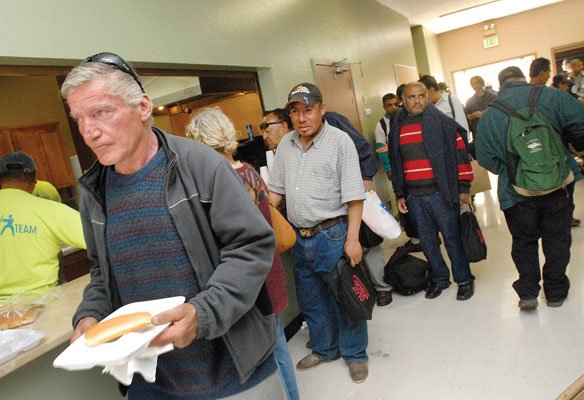A day after Gilroy’s National Guard Armory shelter closed for
the year, homeless residents swarmed First Baptist Church for free
haircuts, medical exams, food, and information about housing and
job opportunities.
A day after Gilroy’s National Guard Armory shelter closed for the year, homeless residents swarmed First Baptist Church for free haircuts, medical exams, food, and information about housing and job opportunities.
The Wednesday event was one of hundreds nationwide based upon San Francisco-based Project Homeless Connect, a program that aims to link homeless residents with care systems that will help them move into housing. The local event was organized by the City of San Jose, St. Joseph’s Family Center, the Gilroy Police Department and several agencies that assist the homeless. The event attracted at least 150 people, who mostly heard about the campaign through flyers and word of mouth.
“Most of the people I see on the street, they’re all here,” said Steve Barrientos, who is homeless in Gilroy. “It’s like the regular crowd.”
Local agencies hosted a similar event in Gilroy four years ago, but Wednesday’s effort was the largest of its kind, participating agencies said.
“We stopped (the former events) because they were big efforts, and we weren’t able to get a lot of results,” said Dina Campeau, a board member of South County Collaborative, an association of nonprofit and public services agencies.
The City of San Jose has taken the lead on several such efforts countywide because it has a “boatload” of resources that other cities do not have, Campeau said.
On Wednesday, St. Joseph’s Family Center pitched in, helping residents sign up for potential housing. Other groups and agencies offered job search programs and medical services.
Rochelle Cleaver, who had been staying at the National Guard Armory, said she hoped the event would help her get a job. Although she has worked with disabled people in the past, she said she is currently out of work and will take any job at this point. Cleaver plans to stay with some girl friends for a few nights now that the Armory is closed, but she is not sure what she will do after that.
“I’ve got to get stable,” she said.
The Armory had food and clothing giveaways throughout the week, and transients there were notified about Wednesday’s event, said shelter director Anthony Perez, who also participated in Project Homeless Connect. The Armory houses up to 125 people nightly from November through March.
A few people at Wednesday’s event tried to get the word out that the Salvation Army has showers – the product of a $50,000 donation from the Merriman family to the Gilroy Foundation last year – at its chapel at Church and Fifth streets. Other advertised services included a “compassion center” at New Hope Community Church on Muraoka Drive, which offers food, prayer and encouragement during specified times of the week.
Most attendees said they found the services and information useful.
“I think it’s great,” said a man who only identified himself as Shawn as he received a haircut from a Gavilan College cosmetology student. “There’s a lot of caring people.”
Several businesses helped out as well. Mike Torres of the Water Warehouse barbecued food for the event, while Arteaga’s Super Save and Kachy Produce donated fruit for the event.
Still, what would really help is if organizers could provide housing for attendees, said a man at the event who called himself Juan Garcia.
“These people need somewhere to live,” he said.
Finding that housing can be a challenge. Campeau said 200 housing vouchers became available in Santa Clara County for that purpose, and she is pushing to get as many of those available in the South County as possible.
In the meantime, many of Gilroy’s homeless residents said they often must move from place to place.
“We’re constantly being chased around,” Barrientos said. “All we want to do is get up and go.”
He cited the eviction of homeless people in early March from the so-called Bamboo Village encampment on private property west of Third Street and Santa Teresa Boulevard as an example.
Ken Wickholm, a former resident at Bamboo Village, said Wednesday that he was able to find a place out on a ranch, but the majority of Bamboo Village residents have just moved further down the creek. Now, without a more formal community, many of them are using the creek as a bathroom and putting trash in the creek.
“They never got rid of nobody,” Wickholm said.
Mayor Al Pinheiro, who attended the event, said reaching out to the homeless is a balancing act between showing compassion toward those without homes and protecting the needs of Gilroy residents who have safety concerns.
Some people say that hosting events such as Project Homeless Connect will attract more homeless people into Gilroy, he said.
“I think the solution is to get them into housing and to help them through the process to make them viable citizens,” Pinheiro said.
Campeau, who refuted the assertion that such services bring homeless people in town, wanted to see what the ultimate impact of the program was in Gilroy. Toward that end, she quizzed some of the agencies on Wednesday about the people they had seen.
Regardless of the long-term impacts of the event, organizers said various services such as haircuts and medical services should at least give attendees a boost in the short term.
“It’s all about esteem and self-respect,” said Dave Newman, law enforcement liaison with Santa Clara County’s Mental Health Department.















